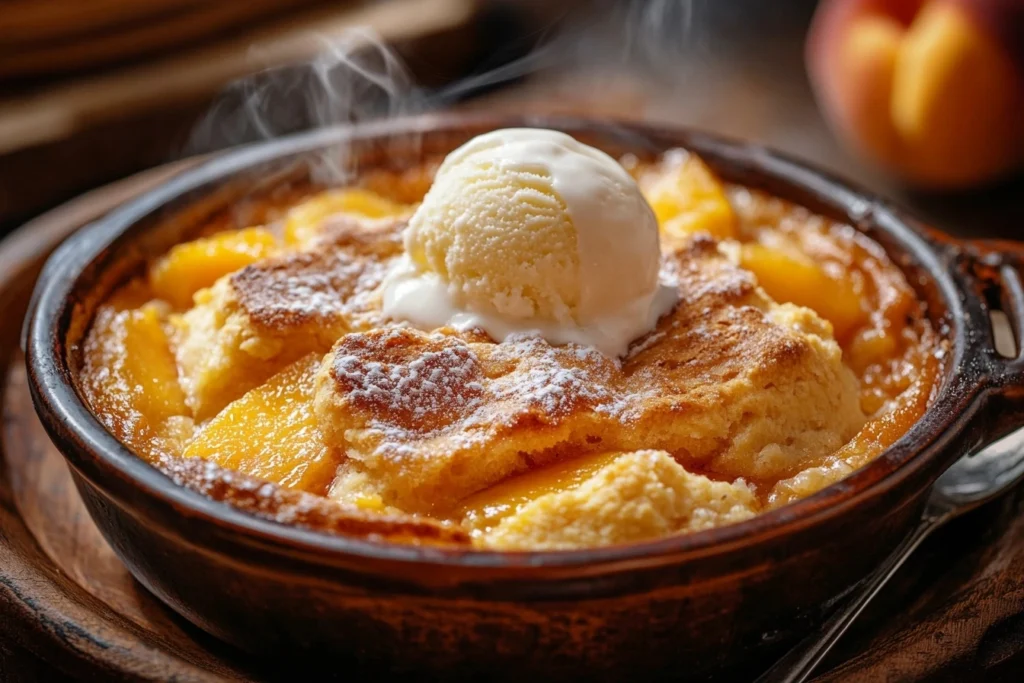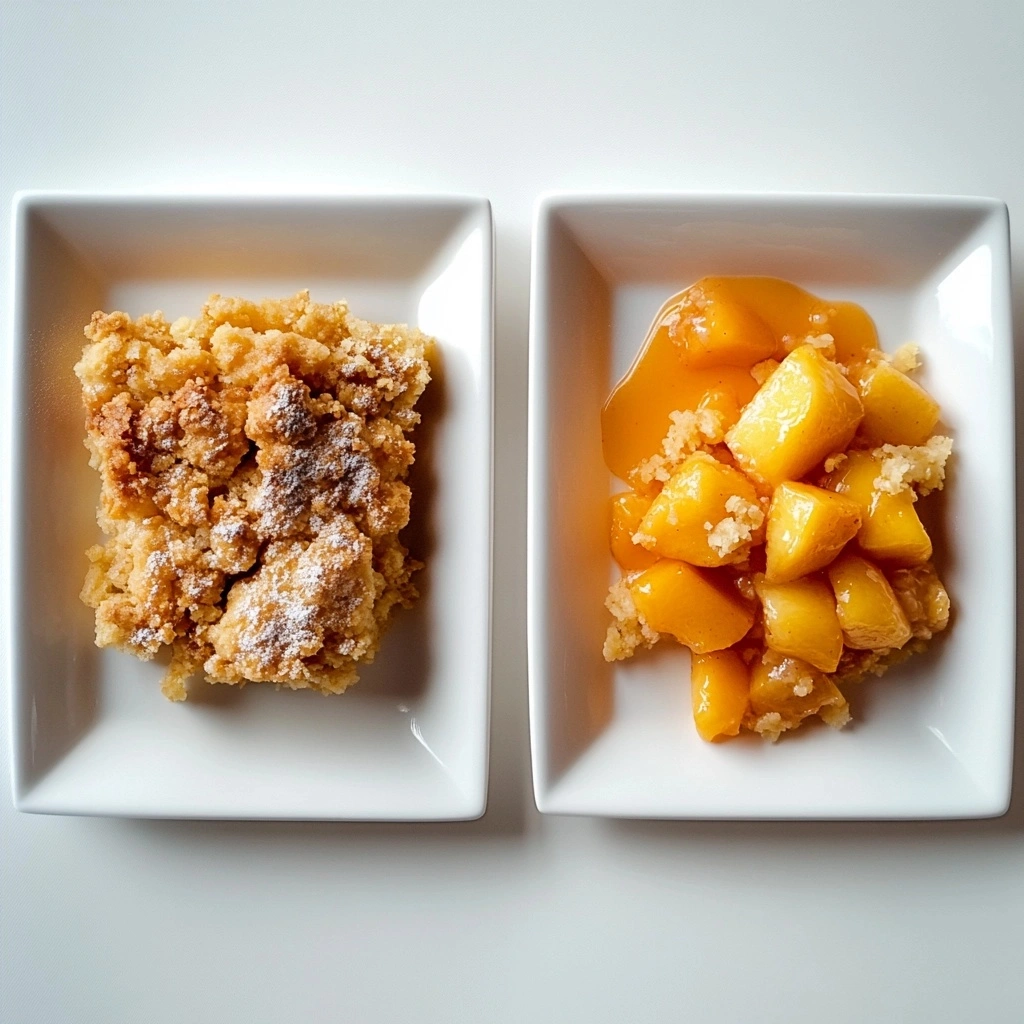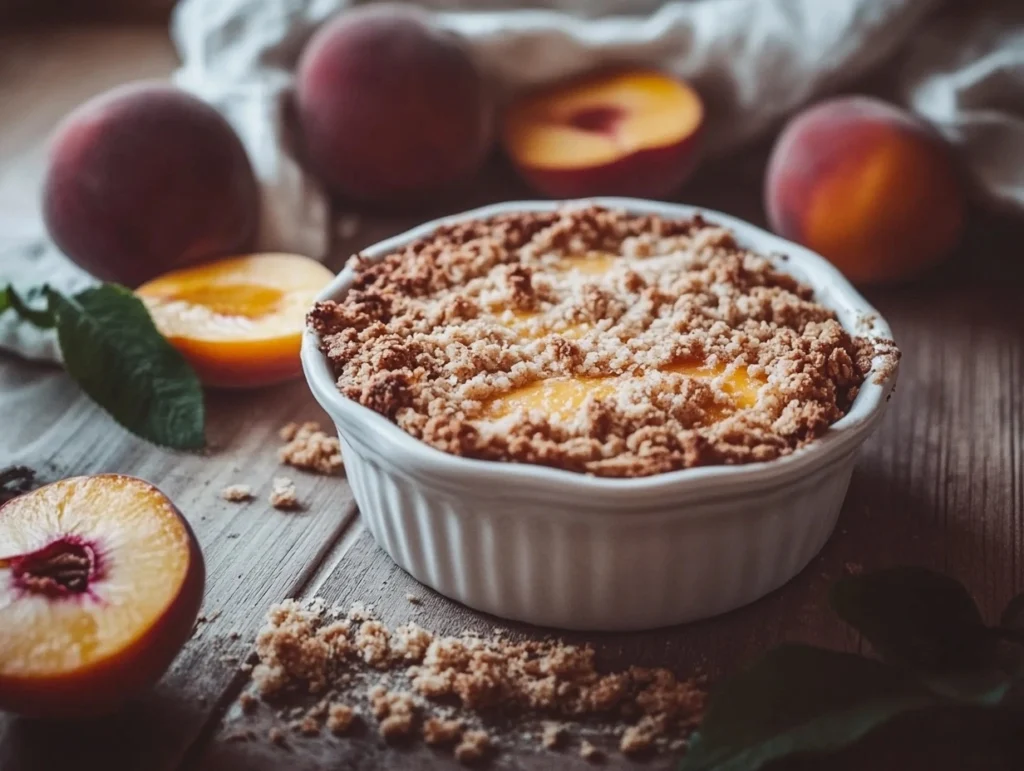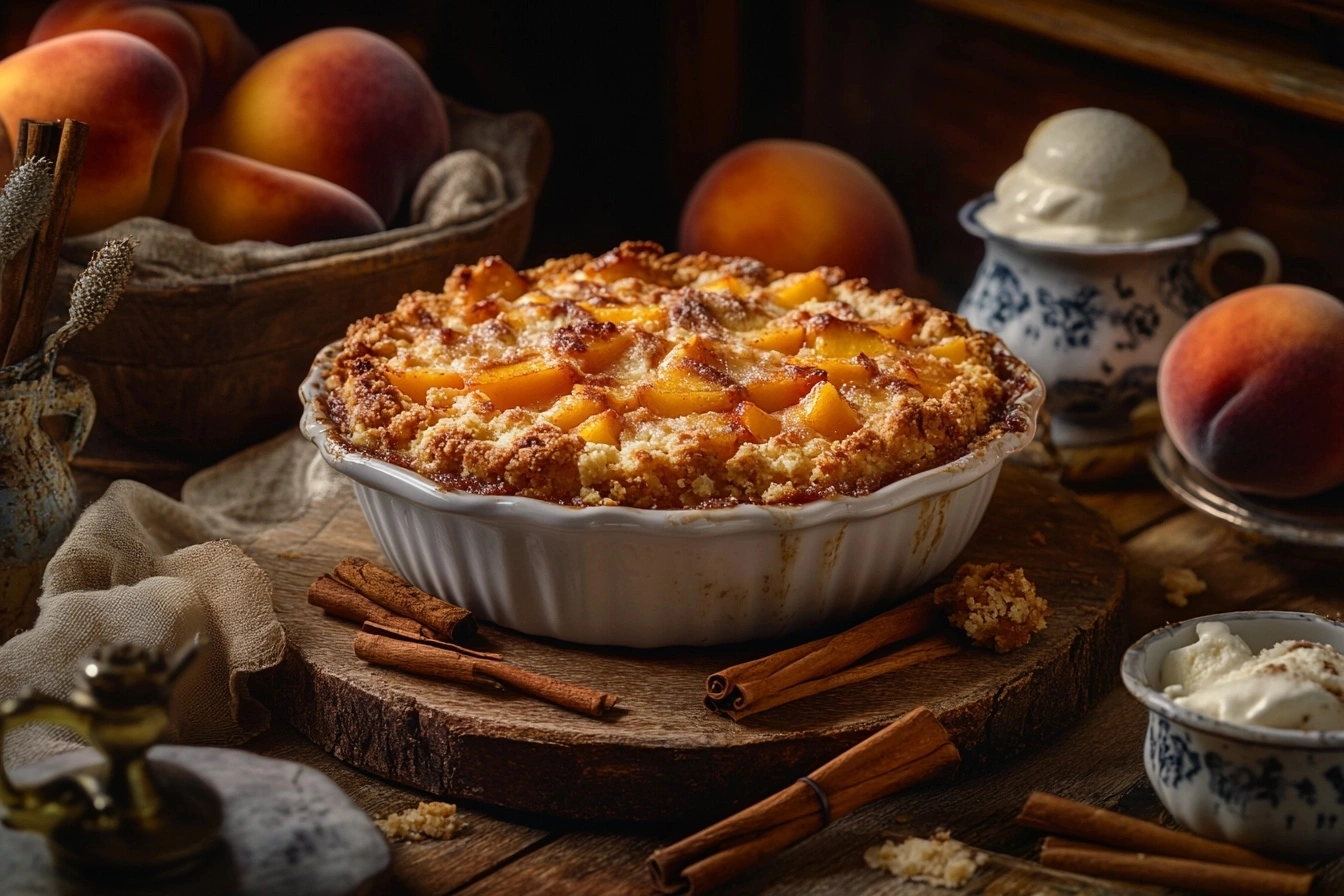Peach desserts are a summertime favorite, but the debate over peach cobbler and peach crumble often leaves many scratching their heads. Both are deliciously fruity, but they’re more than just interchangeable names. This article walks you through the distinct features of each dessert, including their ingredients, textures, and preparation methods, so you’ll never confuse them again.
Understanding Peach-Based Desserts
Popularity of Peach Desserts
Peach desserts hold a special place in the hearts of dessert lovers. From summer barbecues to festive family dinners, they’re the go-to treat when peaches are in season. Among these desserts, peach cobbler and peach crumble are iconic. Their warm, gooey centers and tantalizing toppings make them irresistible, but people often mix up their names or features.
Common Confusion Between Cobblers and Crumbles
Although both desserts involve baked peaches, their differences lie in their toppings and baking styles. Some call a crumble a cobbler and vice versa, but those distinctions matter. By the end of this guide, you’ll understand what sets each apart, making your next dessert decision a breeze. For more detailed tips, recipes, and frequently asked questions, check out this guide on How to Make the Perfect Chocolate Cobbler.
What Is a Peach Cobbler?
Historical Background
The origins of peach cobbler can be traced back to early American settlers who improvised recipes using what they had on hand. Without access to traditional ovens, they baked their desserts over open fires in cast iron skillets. Instead of the pies they knew from Europe, they created cobblers by topping fruit with biscuit dough, which gave the dessert its distinctively rustic appearance. The term “cobbler” likely comes from the dessert’s resemblance to a cobbled stone pathway—uneven, yet charming.
Key Ingredients
A peach cobbler is as simple as it is satisfying, relying on a handful of pantry staples. Fresh or canned peaches form the base, often sweetened with sugar and flavored with cinnamon or nutmeg. The topping, a hallmark of cobbler, consists of a biscuit-like dough made from flour, sugar, baking powder, butter, and milk. The ingredients come together to create a dessert that’s both comforting and indulgent.
Preparation Method
Making a cobbler starts with preparing the peaches. They’re peeled, sliced, and sometimes tossed with sugar and spices. The fruit mixture is placed in a baking dish, and then dollops of biscuit dough are dropped on top. During baking, the dough rises and browns, creating a beautiful golden crust. While it requires some patience as it bakes, the result is a dessert that’s well worth the wait.
Texture and Flavor Profile
Peach cobbler is defined by its contrasting textures. The peaches become tender and juicy, creating a syrupy filling that complements the fluffy, biscuit-like topping. Each bite is a delightful mix of sweetness and spice, often served warm with a dollop of whipped cream or a scoop of vanilla ice cream. Its rustic charm and hearty flavor have made it a favorite across generations.

Comparing Cobblers and Crumbles
Cobblers and crumbles are both delicious desserts, but they have distinct features that set them apart. From the type of topping to how they’re prepared and served, each dessert brings its own charm to the table.
Differences in Toppings
One of the most significant differences between a cobbler and a crumble lies in the topping. Cobblers are topped with biscuit-like dough, which is dolloped or spread over the fruit filling. As it bakes, the dough puffs up, creating a soft and slightly crisp texture. In contrast, a crumble features a streusel topping made from a mixture of flour, sugar, and butter, often with oats or nuts added for extra crunch.
Comparison Table: Toppings
| Feature | Peach Cobbler | Peach Crumble |
|---|---|---|
| Topping Type | Biscuit or cake-like dough | Streusel (crumbly mix of flour, butter, sugar) |
| Texture After Baking | Soft, fluffy, and golden | Crunchy, crumbly, and rich |
| Additional Add-ins | Rarely used | Often includes oats or nuts |
Variations in Preparation Methods
Cobblers and crumbles differ not only in ingredients but also in preparation techniques. For cobblers, the fruit filling is typically cooked slightly before adding the biscuit topping, ensuring a tender filling and a fully baked dough. Crumbles, however, often skip pre-cooking the fruit. The raw fruit is tossed with sugar and spices, with the crumbly topping sprinkled over it before baking.

Texture and Consistency Contrasts
The baked results also distinguish these desserts. Cobblers offer a soft, doughy topping that absorbs some of the fruit juices, creating a moist texture. Meanwhile, crumbles maintain a dry, crumbly texture on top, providing a satisfying crunch with every bite. This contrast in texture is what makes each dessert unique and appealing in its own way.

Serving Traditions and Accompaniments
Both desserts are typically served warm, but the accompaniments can differ. Cobblers are often paired with ice cream or whipped cream to complement the soft, biscuit-like topping. Crumbles, with their crunchy streusel, pair beautifully with custard, cream, or even yogurt for a tangy twist. Regionally, these traditions may vary, but both desserts shine in casual and festive settings alike.
Although peach cobbler and peach crumble have distinct differences, they also share several commonalities that make them cherished desserts. Their focus on showcasing the natural sweetness of fruit and creating a sense of warmth and togetherness makes both options universally beloved.
Fruit Base and Sweetness in Peach Dessert Differences
At their core, both desserts rely heavily on a fruit base, with peaches often taking center stage during their peak season. The fruit is sweetened with sugar to highlight its natural flavor, and spices like cinnamon or nutmeg are sometimes added for depth. Whether nestled under a biscuit topping in a cobbler or a streusel topping in a crumble, the fruit transforms into a soft, syrupy base during baking. This shared emphasis on fruit gives both desserts their irresistible appeal.
Baking Techniques in Cobbler vs Crumble
The process of baking is another similarity between these desserts. Both cobblers and crumbles are baked until the fruit mixture bubbles and the topping reaches its perfect texture—whether that’s the soft, fluffy crust of a cobbler or the crunchy, crumbly layer of a crumble. Timing is essential; underbaking can leave the fruit too firm, while overbaking risks drying out the topping. Despite their topping differences, the shared goal is to harmonize the fruit and topping for a perfectly balanced dessert.
Seasonal Popularity of Peach Cobbler and Crumble
Both desserts are quintessential summer treats, with peaches at their ripest between June and August. However, their adaptability makes them suitable year-round. In cooler months, they’re often prepared with other fruits like apples or berries, bringing the same warmth and comfort to the table. Whether enjoyed at a summer picnic or during a holiday gathering, these desserts are perennial favorites that suit any occasion.
Regional Takes on Peach Cobblers and Peach Crumbles
The universal appeal of peach cobblers and peach crumbles transcends geographical boundaries. Each region adapts these desserts to its local tastes and traditions, reflecting cultural nuances and available ingredients. From the Southern charm of the United States to the cozy kitchens of Britain, these desserts connect people through shared enjoyment.
North American Variations: Peach Cobbler Comparison Across the U.S.
In the United States, peach cobbler holds a special place in Southern culinary tradition. It’s a staple at gatherings, from summer picnics to Thanksgiving feasts, often baked with a soft biscuit or cake-like batter topping. Some variations, like the “deep-dish cobbler,” are especially popular in the South, showcasing the region’s love for comforting, home-style dishes.
Crumbles, while not as historically rooted in American cuisine, have gained traction for their crunchy texture and ease of preparation. They’re now frequently featured on menus and at home dinners, appreciated for their adaptability and quick assembly.
British and Commonwealth Versions: Crumble Recipe Differences Across Regions
In Britain, crumbles originated during World War II, when rationing made pies impractical. This dessert became a creative solution, substituting traditional pie crusts with a crumbly mixture of flour, sugar, and butter. While peaches are used occasionally, British crumbles are more commonly paired with apples, rhubarb, or berries.
Cobblers, though less common in Britain, resemble a dessert called a “gratin,” which involves fruit baked with a lighter, bread-like topping. In Commonwealth countries like Australia and Canada, local flavors influence these desserts. Australians might use tropical fruits like mangoes or pineapples, while Canadians often add maple syrup or incorporate local fruits like Saskatoon berries into their cobblers or crumbles.
Cultural Importance in Different Regions: Peach Dessert Differences with Meaning
In the Southern U.S., cobblers are more than just a dessert—they symbolize family, tradition, and hospitality. Recipes are often passed down through generations, maintaining their cultural significance. In the UK, crumbles evoke nostalgia, often linked to comforting childhood memories or cozy evenings at home. Across all regions, these desserts share a common theme: uniting people through the warm, wholesome experience of enjoying a fruit-filled dish.
Wherever you find yourself, both peach cobbler and peach crumble prove that a simple, well-made dessert can cross borders and generations alike.
Health Aspects of Peach Cobblers and Peach Crumbles
While peach cobblers and peach crumbles bring undeniable delight to the table, they are indulgent treats best enjoyed in moderation. Gaining insight into their nutritional profiles helps determine how to savor these desserts responsibly as part of a balanced diet.
Caloric Content in Peach Dessert Differences
Both desserts are calorie-dense, primarily due to their toppings and sweetened fruit bases. A typical serving of peach cobbler with its biscuit-like topping ranges from 300 to 450 calories. Peach crumbles, topped with a rich streusel, also fall into a similar caloric bracket. The fruit itself provides natural sugars and vitamins, but the additional sugar and fat in the toppings significantly increase the calorie count.
Sugar and Fat Levels: Crumble Recipe Difference vs. Cobbler
The sweetness in both desserts comes from added sugars, complementing the natural sugars in peaches. Crumbles often incorporate brown sugar into their topping, making them slightly sweeter than cobblers. Cobblers might use less sugar in the dough, giving them a subtler sweetness. Regarding fat content, crumbles may have the upper hand due to their butter-heavy streusel topping, while cobblers might use smaller amounts of butter in the dough. Regardless, both desserts are occasional indulgences rather than daily fare.
Potential for Healthier Alternatives in Peach Dessert Differences
The versatility of both desserts allows for creative, healthier tweaks. Reducing added sugar in the fruit base or swapping in natural sweeteners like honey or maple syrup can cut back on unnecessary sweetness. Opting for whole wheat flour in the topping adds fiber, and replacing part of the butter with Greek yogurt can lower the fat content. For crumbles, incorporating oats, nuts, or seeds provides an extra nutritional boost while retaining the crunchy texture. Choosing fully ripe peaches ensures a naturally sweet foundation, reducing the need for excessive sweeteners. For more tips on making desserts healthier, check out this comprehensive guide on healthy eating.
With these modifications, you can enjoy the comforting flavors of cobblers and crumbles guilt-free—proof that indulgence doesn’t have to mean excess.
Common Myths About Cobblers and Crumbles
Misunderstandings in Peach Cobbler Ingredients and Crumble Recipe Differences
One of the biggest myths surrounding peach cobbler comparisons and peach crumble recipes is the belief that the two desserts are interchangeable. Many mistakenly assume they’re identical, differing only in name. However, this couldn’t be further from the truth. For instance, a cobbler’s biscuit-like topping is entirely different from the crumbly streusel topping of a crumble. Crumbles often incorporate oats and nuts for texture, while cobblers stick to a straightforward dough base. These subtle peach dessert differences significantly impact their texture and flavor.
Confusion with Other Desserts: Cobbler vs Crumble vs Crisp
The cobbler vs crumble debate often includes confusion with other baked fruit desserts like crisps or buckles. A crisp resembles a crumble but always uses oats in the topping for added crunch, making it distinct from a crumble’s optional oat addition. Buckles, on the other hand, feature a cake-like batter that rises around the fruit, creating a denser dessert. Such mix-ups often lead to mislabeled dishes at bakeries and leave dessert enthusiasts scratching their heads over these peach dessert differences.
How to Choose Between a Cobbler and a Crumble
Occasion Suitability: Peach Cobbler Comparison for Gatherings
When considering peach cobbler vs crumble, the event’s nature often determines the better fit. Cobblers, with their hearty biscuit topping, excel as warm comfort foods for cozy dinners or cooler months. Meanwhile, crumbles—thanks to their light and crunchy texture—are perfect for summer picnics or dessert spreads where you want something refreshing and versatile.
Personal Taste Preferences in Peach Dessert Differences
Choosing between a peach cobbler comparison or a crumble recipe difference often boils down to texture preferences. If you enjoy the softness of a biscuit topping that absorbs the sweet juices of peaches, cobblers will likely win your heart. On the other hand, if you crave the buttery crunch of a streusel topping, with optional oats or nuts, a crumble will be your go-to.
Ease of Preparation in Cobbler vs Crumble
When it comes to preparation, crumbles tend to be easier. A crumble recipe difference lies in its simple assembly—just mix and sprinkle the streusel topping over raw or lightly prepared fruit. Cobblers, requiring dough preparation and sometimes pre-cooking the fruit filling, demand a bit more effort. For busy bakers or those newer to desserts, crumbles offer a fuss-free yet delightful option.
Frequently Asked Questions
Can I use other fruits besides peaches?
Absolutely! Cobblers and crumbles are versatile desserts that can feature a variety of fruits. Common alternatives include apples, berries, cherries, and plums. Seasonal fruits often work best, as they’re naturally sweeter and juicier. You can even mix fruits—think peach and raspberry cobbler or apple and blueberry crumble—for a unique flavor combination.
How to make a chocolate cobbler?
Chocolate cobbler is a decadent twist on the traditional fruit cobbler. To make it, you’ll prepare a chocolate batter using cocoa powder, sugar, flour, and milk. This is poured into a baking dish and topped with a mixture of sugar and cocoa powder. Boiling water is poured over the batter before baking, creating a gooey, fudgy center with a crusty top. For a detailed step-by-step recipe guide, visit How to Make a Chocolate Cobbler.
What is chocolate cobbler?
Chocolate cobbler is a rich, chocolate-based dessert with a molten center and a baked crust on top. It’s similar to a lava cake but larger and served in a dish. The combination of textures—soft and gooey beneath a crispy topping—makes it an irresistible treat.To dive deeper into its history and unique characteristics, visit What Is Chocolate Cobbler? A Delicious Southern Dessert Explained.
How to BBQ right chocolate cobbler?
BBQ chocolate cobbler has become a favorite outdoor dessert for gatherings and camping adventures. To prepare it, spread the cobbler batter and topping into a cast-iron skillet, cover the skillet tightly with foil, and place it on a grill or smoker. Use indirect heat to cook the cobbler until the topping sets and the chocolate base bubbles. Its rich, gooey texture and smoky flavor make it a hit at any cookout.
Do you refrigerate chocolate cobbler?
Yes, it’s best to refrigerate any leftover chocolate cobbler to keep it fresh. Cover the dish tightly with plastic wrap or transfer the cobbler to an airtight container. Reheat servings in the microwave or oven before enjoying.
How to make chocolate pecan cobbler?
Chocolate pecan cobbler combines the rich flavor of chocolate with the nutty crunch of pecans. Prepare a chocolate cobbler batter and sprinkle chopped pecans over the top before baking. The pecans add a delightful texture and complement the chocolate’s sweetness.
Is cobbler supposed to be moist?
Yes, cobbler should be moist but not overly runny. The fruit filling is juicy, and the topping absorbs some of those juices as it bakes. A good cobbler strikes a balance between a syrupy fruit base and a tender, slightly crisp topping.or a detailed guide on achieving the perfect texture, check out Is Cobbler Supposed to Be Moist? A Comprehensive Guide to Perfect Cobbler.
What Is Cobbler Crust Made Of?
Bakers typically make cobbler crust using a biscuit-like dough that combines flour, sugar, baking powder, butter, and milk. Some variations call for a cake batter instead, which reflects regional preferences and individual taste.
Why is my cobbler so runny?
A runny cobbler usually results from too much liquid in the fruit filling or not enough thickening agent, like cornstarch or flour. To fix this, toss the fruit with a bit of cornstarch before baking. Also, ensure the cobbler bakes long enough for the topping to set and the filling to thicken.
Conclusion
Both peach cobbler and peach crumble are delightful desserts that celebrate the natural sweetness of fruit in their own unique ways. While cobblers charm with their soft, biscuit-like topping, crumbles captivate with their crunchy streusel layer. Each dessert has its place, whether you’re enjoying a casual family dinner, hosting a festive gathering, or simply indulging in a sweet treat on a quiet evening.
Understanding their differences—toppings, preparation methods, and textures—makes it easier to choose the perfect dessert for any occasion. Whether you lean toward the rustic charm of a cobbler or the satisfying crunch of a crumble, both desserts are versatile enough to adapt to personal tastes, ingredients, and dietary preferences.
So, the next time someone asks, “What’s the difference between a peach cobbler and a crumble?” you’ll not only have the answer but also a recipe idea or two to share. Whatever you bake, enjoy every warm, fruity, and comforting bite!

